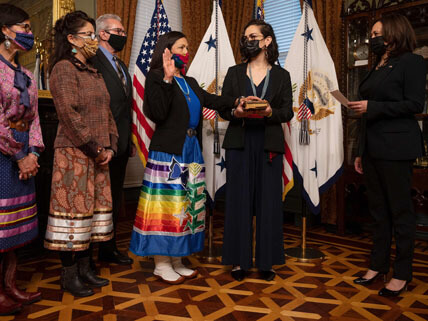
U.S. Vice President Kamala Harris (R) swears in U.S. Interior Secretary Deb Haaland on March 18, 2021 at the Eisenhower Executive Office Building Ceremonial Office in Washington, DC.
On March 16, 2021 Deb Haaland took the oath of office as Secretary of the Interior and became the first Native American to serve as a Cabinet secretary. It was a small ceremony that included her family. A more public ceremony was held on March 18 where the oath of office was administered by Vice President Harris. Secretary Haaland is a member of the Laguna Pueblo in New Mexico, and she was one of the first Native American women elected to the U.S. House of Representatives in 2018.
Haaland commented, “A voice like mine has never been a Cabinet secretary or at the head of the Department of Interior.” Her appointment is remarkable because since its inception in 1849—and for many decades after—the Department of the Interior (DOI) oversaw the systematic abuse and attempted assimilation of Native Americans. Official department policies and legislation often eroded the social fabric of Native American life through the taking of land and creation of divisions.
The Indian Reorganization Act of 1934 sought to reverse some of the worst legislation targeting Native Americans, and further gains for Native Americans were made during the 1970s and 1980s. However, there is still much work to do in addressing historical wrongs against Native Americans. Most people believe that Secretary Haaland will continue to seek progressive expansion of DOI policies toward Native American governments.
The Department of the Interior is a huge organization with a variety of responsibilities. The department currently employs about 70,000 people and is responsible for the management of the natural and cultural resources of the United States. There are 11 bureaus that oversee the department’s primary areas of responsibility:
- Bureau of Indian Affairs
- Bureau of Indian Education
- Bureau of Land Management
- Bureau of Ocean Energy Management
- Bureau of Reclamation
- Bureau of Safety and Environmental Enforcement
- Bureau of Trust Funds Administration
- National Park Service
- Office of Surface Mining Reclamation and Enforcement
- U.S. Fish and Wildlife Service
- U.S. Geological Survey
Secretary Haaland has a complex and challenging task ahead of her that she will not shy away from. In her speech accepting the nomination, Haaland said, “Growing up in my mother’s Pueblo household made me fierce. I’ll be fierce for all of us, for our planet and all of our protected land, and I’m honored and ready to serve.”
Image credit: ©JIM WATSON/AFP via Getty Images
Related Links:
- Department of the Interior
Official website of the Department of the Interior.
(Source: Department of the Interior, March 31, 2021) - Department of the Interior: Bureaus & Offices
Read more about the Department of the Interior’s responsibilities and how the work is divided.
(Source:Department of the Interior, March 31, 2021) - Deb Haaland Becomes First Native American Cabinet Secretary
Read an article about Deb Haaland’s confirmation and the challenges ahead.
(Source: New York Times, March 15, 2021)



